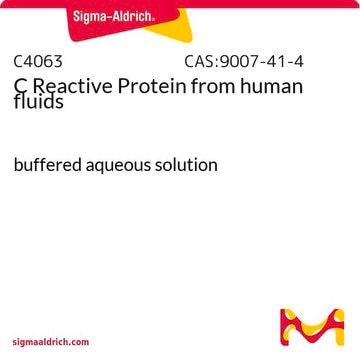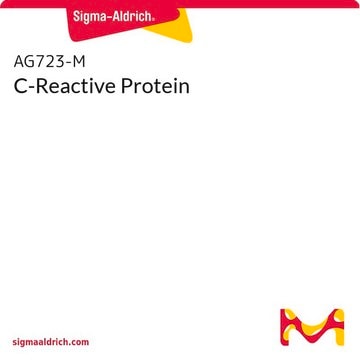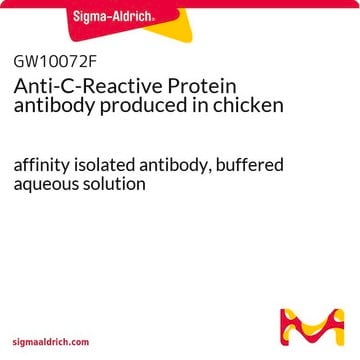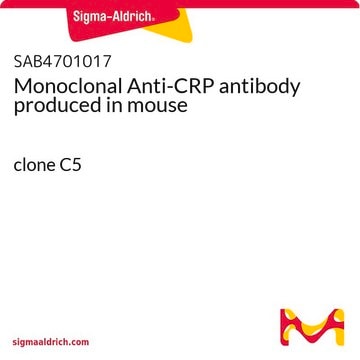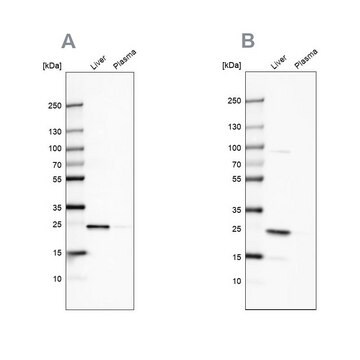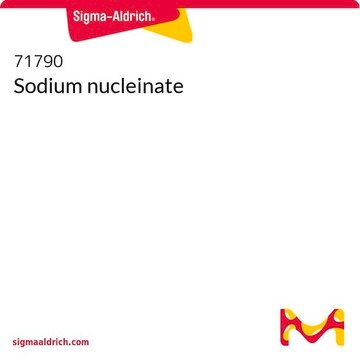C1617
C Reactive Protein human
recombinant, expressed in E. coli, liquid
Sinónimos:
CRP
Iniciar sesiónpara Ver la Fijación de precios por contrato y de la organización
About This Item
Productos recomendados
Descripción general
C-reactive protein (CRP), a homopentameric acute-phase inflammatory protein, is produced mainly in liver hepatocytes. This highly conserved plasma protein is also produced by smooth muscle cells, macrophages, endothelial cells, lymphocytes, and adipocytes. It belongs to the pentraxin family.
Aplicación
C Reactive Protein human has been used:
- as a component in differentiation medium to study the effects of C-reactive protein (CRP) on the size of myotubes and myotube mixed protein synthesis (MPS)
- to study the influence of serum CRP level from elderly on endothelial cell proliferation in human umbilical vein endothelial cells (HUVEC)
- to study the roles and connections of nicotine, monocytic interleukin 6 (IL-6), α7 nicotinic acetylcholine receptor (α7-nAChR), and CRP in the development of coronary artery spasm (CAS)
Acciones bioquímicas o fisiológicas
C-reactive protein (CRP) is a protein that could precipitate the C-polysaccharide of pneumococcal cell walls. CRP is widely used as a clinical marker of the state of inflammation, since its production by hepatocytes increases during the acute phase of the inflammatory response.
C-reactive protein (CRP) plays a key role in the complement pathway, apoptosis, phagocytosis, nitric oxide (NO) release, and the production of interleukin-6 and tumor necrosis factor-α. It participates in the uptake of low-density lipoprotein in macrophages. CRP levels are elevated in people suffering from appendicitis, cholecystitis, pancreatitis, and meningitis. It plays a vital role in the pathophysiology of cardiovascular disease. Hence it is used as a marker of infection and cardiovascular events.
Nota de análisis
A highly purified protein and made by a fermentation process using genetically modified E. coli.
Código de clase de almacenamiento
10 - Combustible liquids
Clase de riesgo para el agua (WGK)
nwg
Punto de inflamabilidad (°F)
Not applicable
Punto de inflamabilidad (°C)
Not applicable
Elija entre una de las versiones más recientes:
Certificados de análisis (COA)
Lot/Batch Number
¿No ve la versión correcta?
Si necesita una versión concreta, puede buscar un certificado específico por el número de lote.
¿Ya tiene este producto?
Encuentre la documentación para los productos que ha comprado recientemente en la Biblioteca de documentos.
Los clientes también vieron
Adrian Hosford-Donovan et al.
Maturitas, 89, 52-57 (2016-05-18)
It is hypothesized that chronic systemic inflammation contributes to the age-related decline in cardiovascular function. The aim of the present study was to combine an assessment of the relationship between the serum level of C-reactive protein (CRP) and systolic and
Ming-Yow Hung et al.
Free radical biology & medicine, 120, 266-276 (2018-04-03)
Smoking and high-sensitivity C-reactive protein (hs-CRP) are risk factors for coronary artery spasm (CAS), which is characterized by the increased interleukin-6 (IL-6) level and monocyte counts; however, limited data are available regarding the role of cigarette-embedded nicotine in the modulation
P P Galanis et al.
Talanta, 238(Pt 2), 123056-123056 (2021-11-22)
We report the use of a laser-based fabrication process in the creation of paper-based flow-through filters that when combined with a traditional lateral flow immunoassay provide an alternative pathway for the detection of a pre-determined analyte over a wide concentration
Britta Wåhlin-Larsson et al.
Cellular physiology and biochemistry : international journal of experimental cellular physiology, biochemistry, and pharmacology, 44(1), 267-278 (2017-11-14)
Mechanisms underlying the relationship between systemic inflammation and age-related decline in muscle mass are poorly defined. The purpose of this work was to investigate the relationship between the systemic inflammatory marker CRP and muscle mass in elderly and to identify
Nicola R Sproston et al.
Frontiers in immunology, 9, 754-754 (2018-05-01)
C-reactive protein (CRP) is an acute inflammatory protein that increases up to 1,000-fold at sites of infection or inflammation. CRP is produced as a homopentameric protein, termed native CRP (nCRP), which can irreversibly dissociate at sites of inflammation and infection
Nuestro equipo de científicos tiene experiencia en todas las áreas de investigación: Ciencias de la vida, Ciencia de los materiales, Síntesis química, Cromatografía, Analítica y muchas otras.
Póngase en contacto con el Servicio técnico